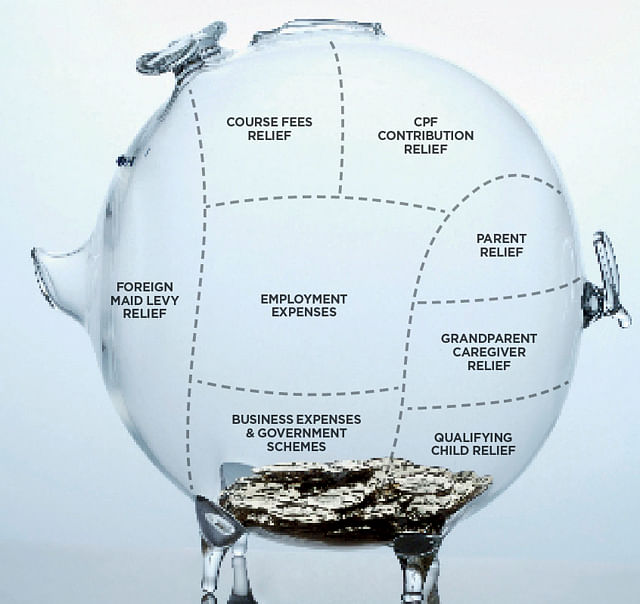
DON’T FORGET TO CLAIM YOUR EMPLOYMENT EXPENSES
So you bought your client lunch but your boss won’t reimburse you for it. If you incurred such expenses while carrying out your job – just make sure the expenses are not capital or private in nature – you should keep your receipts and claim them under your allowable expenses. According to the Inland Revenue Authority (Iras), apart from entertainment expenses for your clients (particularly important for those who entertain often), you can also claim for transport expenses on public transport, subscriptions paid to professional bodies or societies, and even religious dues such as for a mosque building fund.
MILK YOUR COURSE FEES RELIEF
Singapore is big on productivity and encourages continual training and learning. So, if you’ve signed up for courses to upgrade your skills, IRAS will give you props for enhancing your employability by letting you claim Course Fees Relief.
This benefit is only for those currently, or previously, working and who are attending long- or short-term courses that lead to an approved academic or professional qualification. It doesn’t apply to those who are studying for a diploma or university degree and have not worked previously.
So, if you are studying for your masters, which easily costs anything from $15,000 to more than $30,000, consider spreading out your course fees payment over different years, so that you can claim the maximum $5,500 per year. If you decide to pay the fees in full – though this is less common – you can also divide that equally over the period of the course. For example, shelling out $21,000 for a three-year masters programme works out to $7,000 per year. However, you can only claim a maximum of $5,500 per year.
If you took several courses, you can claim for all of them, capped at a maximum of $5,500 per year. On top of the tuition fees, you can also claim for the registration or enrolment fees, examination fees and aptitude test fees.
TOP UP YOUR CPF ACCOUNTS
Many people already know about the CPF cash top-up relief, an incentive to encourage Singaporean citizens and Permanent Residents to top up their Retirement or Special accounts with cash. You also enjoy the same relief if you top up your family members’ accounts.
For most people who are employees in a company, you already get monthly contributions to your CPF accounts. Thus, you also automatically enjoy the CPF Contribution relief. However, if you are self-employed or work freelance, you are not legally obligated to contribute to your CPF account, except for your Medisave account.
Remember, any CPF contribution you make will receive tax relief, which helps to lower your net taxable income. As a self-employed person, you can voluntarily contribute to your Ordinary Account.
This comes in handy if you’re servicing a housing loan. If you’re currently paying for your property with cash, consider topping up your Ordinary Account and using that to pay for your property instead. That way, you’ll get to enjoy the CPF Cash top-up relief!
But do remember that once you’ve sold off your property, proceeds of the sale will first go towards paying back the CPF money that you’ve utilised, with interest.
CLAIM TAX RELIEF FOR BEING FILIAL
If you’ve supported dependants like your parents, grandparents or great-grandparents by spending or giving an allowance of at least $2,000 in 2014, you can enjoy this tax relief as a pat on your back for your filial piety. The dependant has to be living in Singapore in 2014, aged 55 years or above (this rule is waived if the dependant is physically or mentally disabled) and he or she made no more than $4,000 in 2014, be it from trade, employment, property rental income for bank interest, dividends and pensions, and money made abroad (e.g. from rental of an overseas property).
Do note: if you have several siblings all supporting your parent, only one sibling can make the claim or you can split the Parent Relief. If your parent is living with you, you can claim $9,000 for each dependant ($14,000 if your parent is handicapped). If your parent is not, you can still claim $5,500 for each dependant ($10,000 for a handicapped parent).
CLAIM GRANDPARENT CAREGIVER RELIEF
This is a goodie just for working mums. If you’re roped in your (or your husband’s) parent or grandparent to help care for your children, don’t forget to file your tax claim!
As long as your parent, grandparent, parent-in-law or grandparent-in-law was living in Singapore in 2014, did not work or carry out any trade, business, profession or vocation and had looked after any of your kids who are Singaporeans and 12 years old or younger last year, you can claim a relief of $3,000 on one of them.
CLAIM QUALIFYING CHILD RELIEF – EVEN IF YOUR CHILD HAS EARNED SOME MONEY
Most people are aware that they can claim Qualifying Child Relief – from $4,000 per child – if your child is below 16 years old. What happens if he is in his 20s and studying in university?
Well, as long as your child – even those above 16 years – is studying full-time at an educational institution such as secondary school, polytechnic, junior college or university at any time in 2014, you can enjoy some tax relief.
Can you still claim tax relief if your child works part-time – for example, if your 15-year-old kid worked as a waitress or your 20-year-old university undergrad taught tuition for pocket money? You can, if your child’s income did not exceed $4,000 in 2014.
What if your child did well in school and received scholarships, bursaries or other allowances? Don’t worry, these are not considered as part of your child’s income and will not affect the $4,000 cap.
CLAIM FOREIGN MAID LEVY RELIEF – EVEN IF YOUR HUSBAND PAYS FOR IT
The Foreign Maid Levy relief, meant to encourage married women to continue in the workforce, can help bulk up your reliefs to lower your taxable income. You’re eligible as long as you are married and live with your husband, and you or your spouse employed a foreign domestic worker. Or, you’re married but your husband is not a tax resident in Singapore. It also applies to you if you are separated from your husband, divorced or widowed and have children who live with you; as long as you can claim child relief on your kids, you can claim the Foreign Maid Levy relief.
It doesn’t matter if it’s your hubby or you who paid the levy. This is a privilege only reserved for working mums; your hubby can’t claim it even if he is the one shelling out the levy. Make sure you don’t miss out, as you can claim twice the total levy paid for your maid.
For households with at least one kid under 12, you’d have paid $120 per month or $1,440 for a year. You can claim double that, or $2,880. And if you’re paying the full levyof $265 per month, you can claim a whopping $6,360 in relief!
FREELANCERS AND SELF-EMPLOYED FOLKS, DON’T FORGET TO TAKE ADVANTAGE OF GOVERNMENT SCHEMES
If you’re self-employed or a sole proprietor – this refers to people who work on a commission basis, as well as freelancers, hawkers, private tutors, associate lecturers etc – your income is wholly taxable. But since freelancers don’t usually contribute to CPF accounts monthly (unless you make voluntary contributions), most can’t claim CPF Contribution reliefs against their taxable income.
So don’t miss out on other opportunities to claim tax reliefs. Claim all allowable expenses, such as your public transport costs – keep taxi receipts – and even stationery and postage fees. If you run an online business and often mail out items to customers, this can add up to a significant amount.
If you put out advertisements for your services, they are claimable. Ditto for any repairs and maintenance of your assets used for business, such as laptop repairs. If you suffered bad debts that were irrecoverable during the accounting year, you can also claim them for tax relief.
If you run your own business and have employed at least three local employees, don’t forget to check out the Productivity and Innovation Credit (PIC) scheme. And if you bought or leased Information Technology (IT) and automation equipment – such as computers, printers and software – or hired a web designer to build you a website for your business – you can claim 400 per cent tax deduction on up to $400,000 spending a year. If you choose cash payout, you can only claim 60 per cent against your expenses. Do check http://picgrant.com.sg for more information.
As it stands, Singapore’s income tax rates are already among the lowest in the world. Your first $20,000 of chargeable income is tax-free, and the maximum that top-tier earners ($320,000 and above) pay is 20 per cent of the annual income – which is what an average earner pays in say, Australia.
Still, most of us would rather pay less tax, of course. So don’t get lazy about claiming those tax reliefs – check with IRAS (www.iras.gov.sg), your accountant or do some research on your own to see if you qualify. You could be saving yourself a pretty penny!
This article was originally published in Simply Her April 2015.

